
Differences in Big Rig Systems
Differences in Big Rig Systems
An intro to the appliances and systems of a Class A, with a look at the Winnebago Horizon specifically.
By: Don Cohen
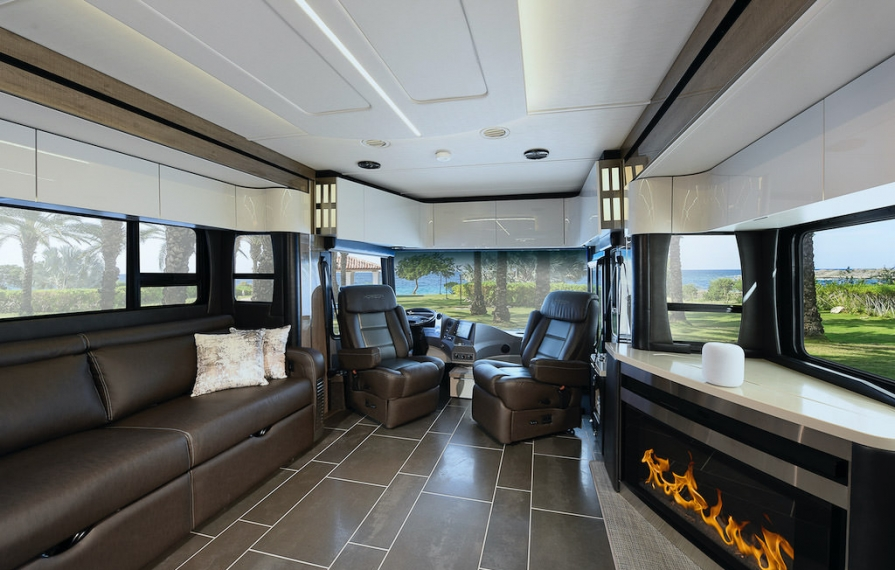
Owning two Navions definitely helped prepare me for quickly learning big rig systems. In some ways, it reminded me of days of yore when I'd help people switch operating systems from PCs to Macs. While the final results were the same, the process in getting there was sometimes different. And so it is with the more sophisticated systems that go into larger coaches.
Think Electric
A few years ago, manufacturers of higher-end diesel pusher coaches made the switch to all-electric house systems. Up until the changeover, house systems for large coaches were a hybrid of propane and electric. A large propane tank would fuel the stove, refrigerator, hot water, and furnace.
Fully electrifying a coach increases component prices such as more banks of batteries, power inverters, and hybrid heating systems. Winnebago's high-value Forza is a hybrid which helps hold the price down by combining electric appliances like a refrigerator and microwave, but relies on propane driven hot water, heat, and stove. On the other hand, our Horizon is fully electric with a diesel heating system.
Refrigerators
One of the biggest innovations in RVs has been the use of electric refrigerators. Electric refrigerators use a compressor which helps them cool down faster, operate when less than level, and work at high altitudes. While big rigs use standard home refrigerators, Winnebago has been finding and using more all-electric compressor driven compact fridges for their B and C products because of their better performance.
Our Horizon has a 23-cubic-foot Samsung with French doors, icemaker, and pull-out lower freezer. And if that weren't enough, we have a small Dometic refrigerator/freezer that rolls out from one of our bays below. It too is fully electric.
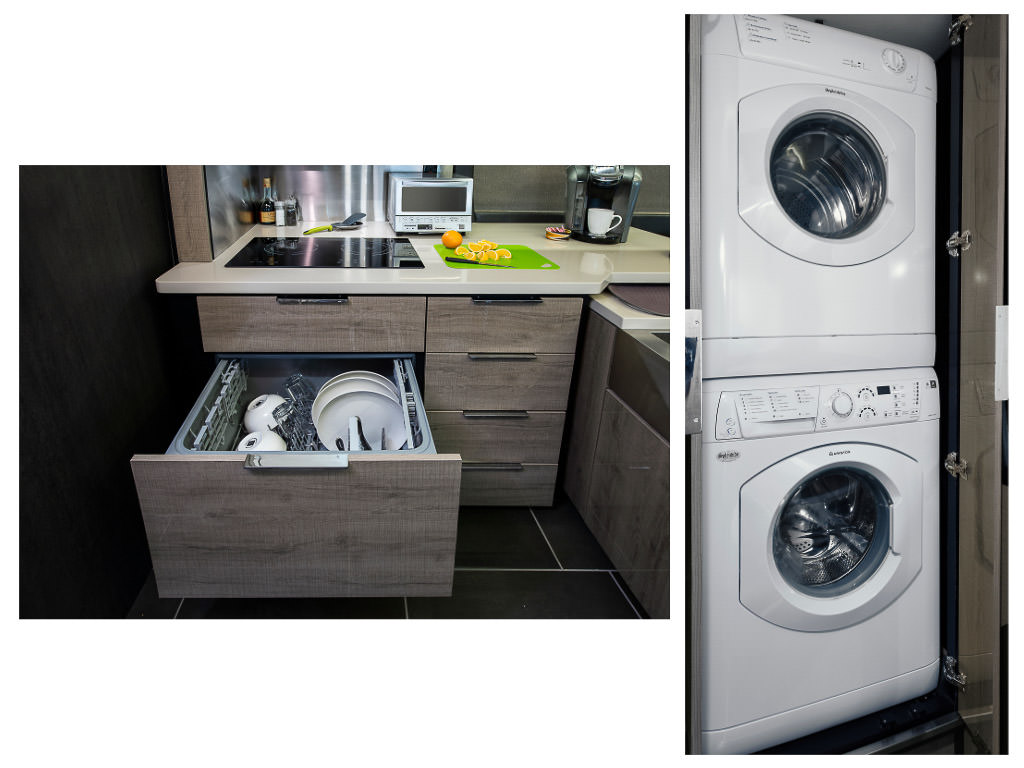
Residential style appliances such as a washer/dryer, induction cooktop, and dishwasher require more robust hot water and electrical systems.
Induction Cooktop
While we also have a convection oven/microwave combination, another big difference is our cooktop is an electric induction. Induction tops require magnetic attracting pans and are far more efficient at quickly heating (and controlling temperature) over propane. They're also cooler inside the coach for cooking during warmer weather.
Other Appliances
Our other 110V appliances include the dishwasher, washer and dryer, and three roof air conditioners. Everything else, from lighting to the toilets, are 12V.
For large coaches, RV designers need to take into account the significant power draw with the assumption that someone might want to have all the air conditioners running while using the microwave and running a load of laundry. That's why there's a big fat four-pin plug and cable that we drag out to the power pedestal for 50-amp service. It's also why there's a hidden bank of six large AGM batteries underneath the coach (enough to run the refrigerator for two full days without any power), and a 10,000-watt diesel generator. Ya gotta have juice!
Class C to Class A Differences
Diesel pusher coaches are, by use and custom, far more likely to be plugged in at campgrounds rather than being found in the wild off the grid, though they're elegantly capable of doing such (especially with large water tanks). Many big rig owners pay little heed to monitoring their electrical systems as most functions happen quietly in the background. One of the most notable differences in our switch from a Navion to a Horizon was, when I plugged into shore power, I'd hear a relay click that automatically switched from battery power to shore. No switch to flick or replugging power once disconnected from the pedestal. A small, but meaningful upgrade.
Along those same lines, our coach is equipped with auto-generator start (AGS) for those times when you are boondocking. When running off of house batteries, the AGS circuitry monitors the charge of your batteries and, if it senses a drop below a certain voltage (you can pre-set), it will automatically turn on the generator and run until the batteries are topped off. We tested this feature one night at a truck stop and it worked as advertised. It also pointed out another great large coach benefit. With the generator at the front of the coach and the bedroom at the back, noise and vibration were so minimal that we weren't disturbed while sleeping.
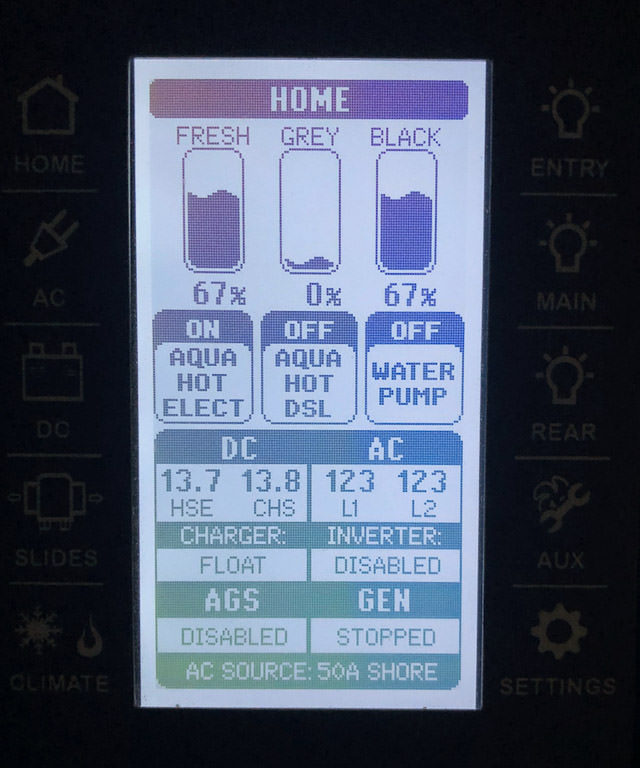
One of several monitoring screens from the Firefly multiplex system, so you can keep an eye on resource usage and system status.
Feel the Heat
For decades, the RV industry has used propane-fired gas forced air furnaces. In the forty years from when my father bought his first motorhome, to our two Navions, about the only thing that changed was adding an auto-igniter to keep the pilot flame lit. When the switch to all-electric coach design happened a few years ago, a couple of companies (Oasis and AquaHot) introduced products that ran off of diesel. Winnebago currently uses the AquaHot product and it's a total winner.
The AquaHot recirculates glycol through tubes that run to strategically placed vents in the coach. Think of them like radiators. Each vent has a blower fan that, when heat is called for, the system pumps warm glycol through the tubes and the blower pushes air across them and into the coach. It works exceptionally well and is very quiet.
The AquaHot is essentially a near-instantaneous flash heater that not only circulates the glycol for heat but hot water for domestic use. The unit has both diesel-fired burners and electric elements. What's great is that you can use either or both. To warm up the coach quickly (or get super-hot water), I turn the diesel burner on. It's very quiet and all you hear is a slight buzz when it's operating. When the diesel burner is running, there's no smoky or smelly exhaust. It's very clean and efficient. When plugged into a 50A circuit during mild weather, the electric-only setting is perfect. With a larger coach, we have control over multiple heat zones, including the underneath storage. This is great for using the coach in cold weather to keep the water lines from freezing.
As for the fireplace, some may wonder if electric fireplaces are dorky? Surprisingly, no. New designs are visually appealing, and a small hot-air fan is a great addition to the in-coach heating system. Truly comfy.
On the Level
Despite the hopes of members of the "Flat Earth Society" that they will someday prevail with their two-dimensional belief, any RVer knows that the world is not flat. Our PowerGear levelers do a great job of leveling the coach. They have manual adjustment capability that allows you to fine tune, but I've rarely had to tweak. In our two Navions, I had installed aftermarket HWH levelers which were simply fantastic, though expensive. For small rigs, you often find yourself adventure parking. With big rigs, you're a lot fussier and selective - making sure that a site (campground or Walmart parking lot) is reasonably level. For years (especially with an RV refrigerator), the little bubble level came out on the floor to make sure we were in the circle. With a big rig, the importance of leveling isn't for the fridge, but for your slides.
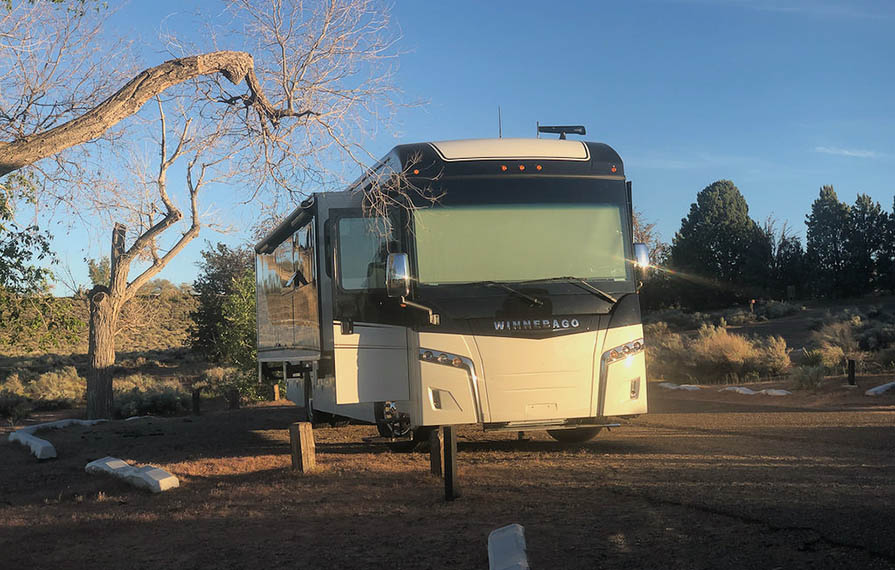
A great view, but not a very level site at Lake Powell. Big rigs with big slides really need to be as level as possible.
Large slides are heavy and, even with a lot of engineering reinforcement, as they extend and retract, it puts a lot of stress on tight geometry. If your coach is not fairly level, your slides may not fully push out or, worse yet, retract. We had a breath-holding moment pulling our full-wall slide back in at a campground in Wahweep (Lake Powell) earlier this year. We were on a grade sloping outwards. The slide (with gravity helping) pushed out without any issue. When we were getting ready to depart, the slide came about halfway in and struggled to a stop as the sidewall was binding. I prayed that the side jacks weren't all the way extended and used the manual control to get just a little more rise out of them. Whew! It worked. That close call reminded me that I needed to get a set of jack pads to give me a little extra lift in higher slope situations. At $80, the Quality Plastics four-pack of jack pads is a lot more expensive than most, but for big rigs they are very heavy duty and well made.
Read 'em ... and Don't Weep
When you're first learning about all your big rig systems, it can seem complicated and confusing. In reality, most of these systems work seamlessly and automatically. What can be intimidating is all the fine-tuning adjustments you are presented with (most of which you'll never use). And, like anything, once you're using your coach, you'll quickly become very comfortable (both physically and mentally) with all the benefits.
While the learning curve is steeper for the numerous systems in a big rig, Winnebago has all their manuals online as downloadable PDFs. I know that I'm in a small minority of the population who actually reads a manual. Whether it's for computers, consumer electronics or motorhomes, I've always found that a first reading (or at least skimming) helps me understand the product. The real payoff comes in reading the manual(s) after using the product for a little while. Stuff makes a lot more sense and I always have a few "I didn't realize that" moments when re-reading. For buyers of both new and used Winnebago motorhomes, reviewing the manuals prior to purchasing can help you ask sharper questions.
The good news is that, over time, you tend to quickly internalize all the little checklists, protocols and quirks in RV operation, and you'll focus more on enjoying life and being more at home, on the road.
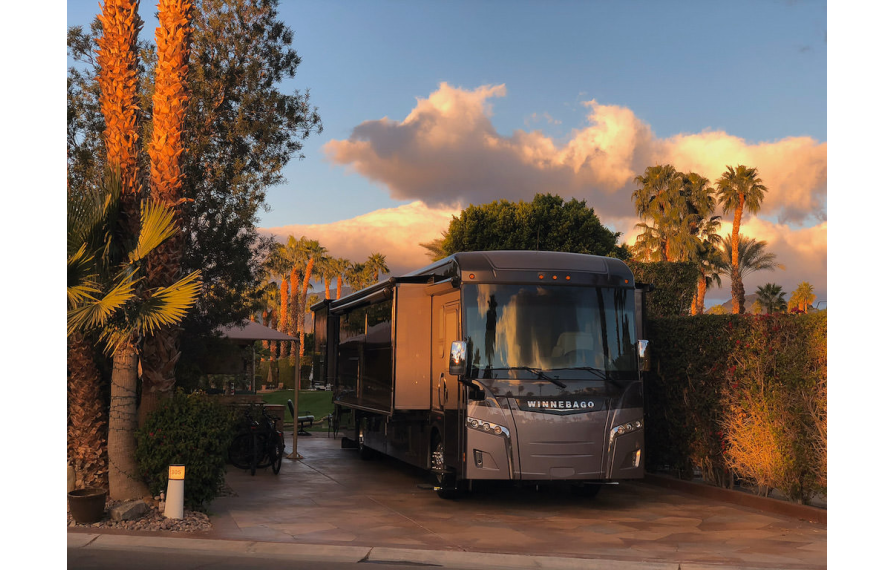
Moving Up & Down the Continuum
Going back to my tech roots, even when one switches operating systems, it doesn't mean you don't find value in using a computer. The great thing about RVs is that, as your interests and needs change over time, you can journey along a continuum of choices from small to large, utilitarian to luxurious, and back again. Upsize, downsize, rightsize.
Where has your ownership journey taken you?
Comments
Comments on this post are moderated, so they will not appear instantly. All relevant questions and helpful notes are welcome! If you have a service inquiry or question related to your RV, please reach out to the customer care team directly using the phone numbers or contact form on this page .